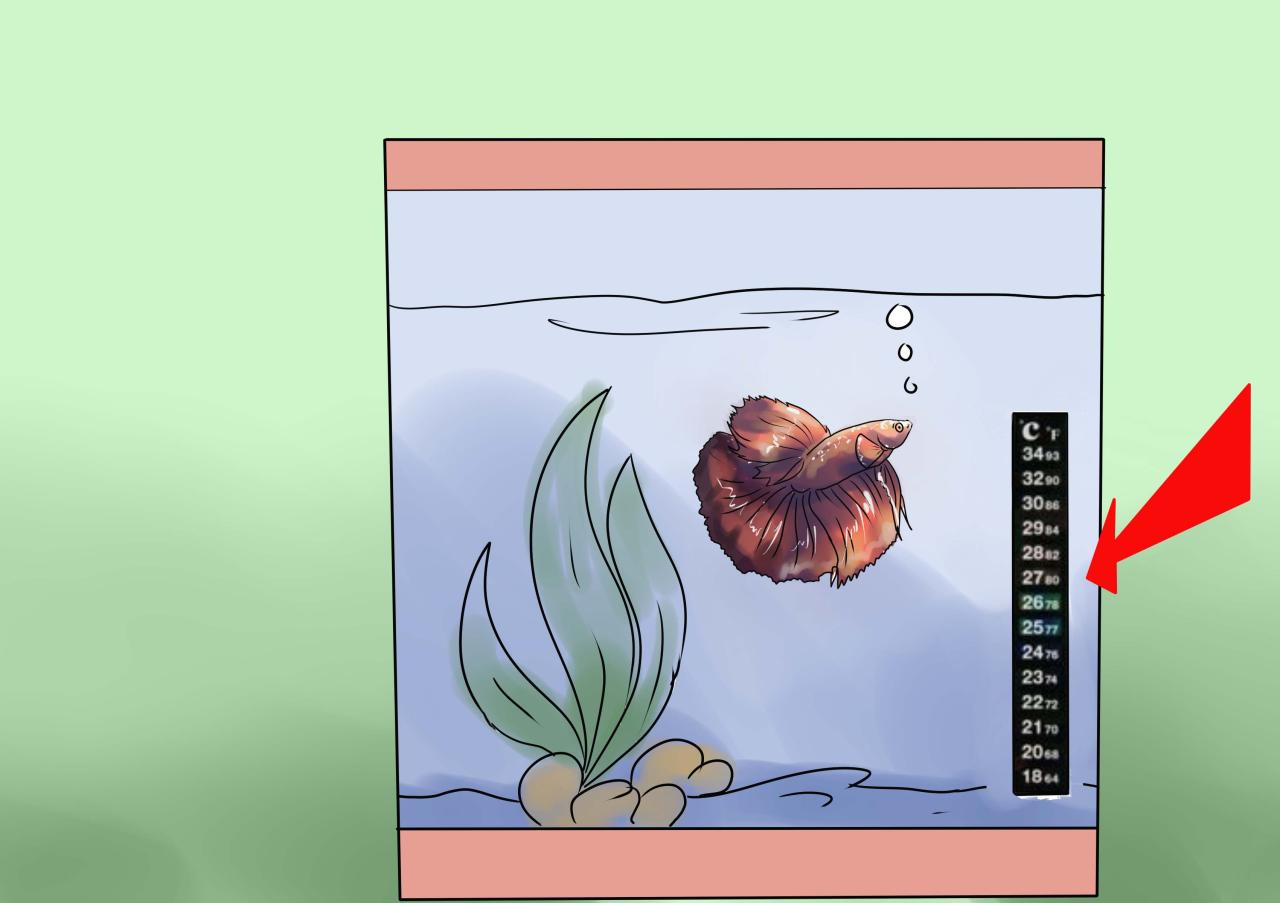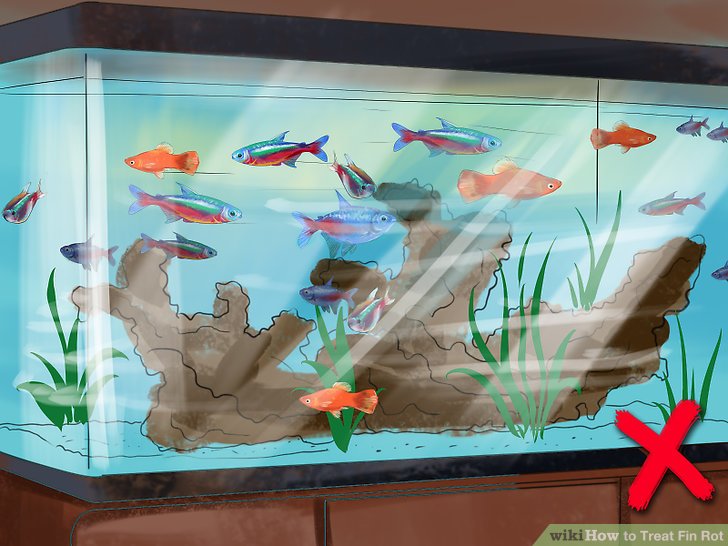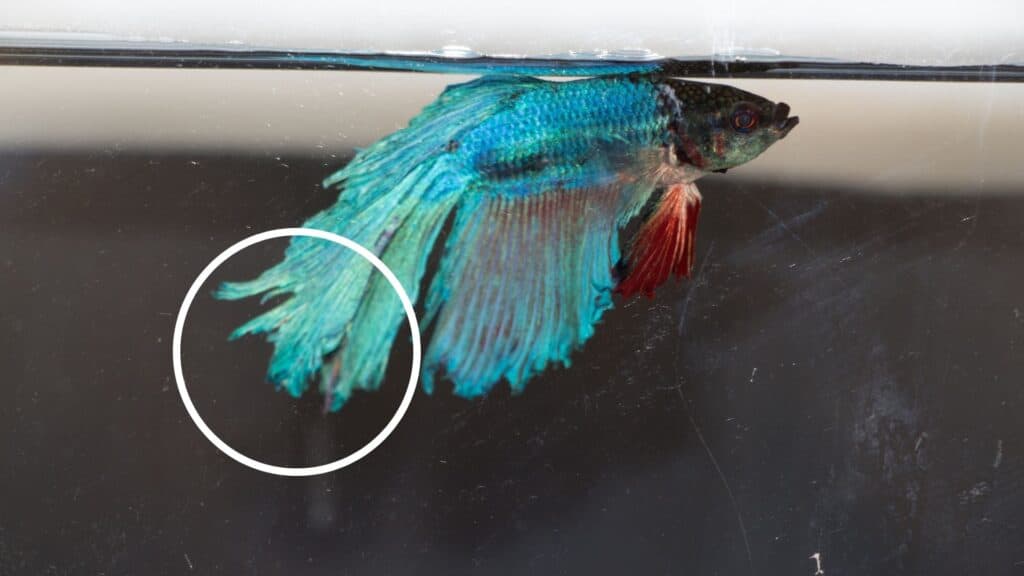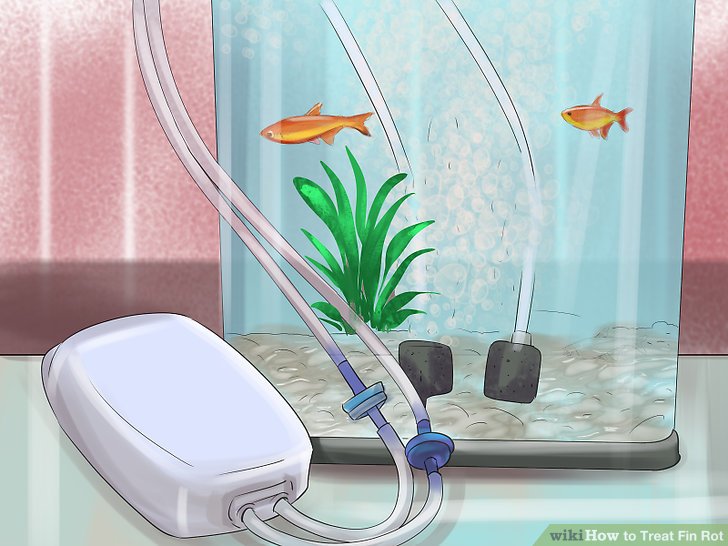Fin rot, a common ailment affecting aquarium fish, can lead to significant distress and even death if left untreated. This comprehensive guide provides a detailed understanding of fin rot, from its identification and diagnosis to effective treatment and preventative measures. We will explore the various stages of the disease, its causes, and the importance of maintaining optimal water quality for successful recovery.
The guide meticulously covers all aspects of treating fin rot, including the selection and application of appropriate medications, the creation of a quarantine environment, and crucial steps in maintaining proper water parameters. By understanding the specifics of this fish disease, you can equip yourself with the knowledge necessary to provide your fish with the best possible care.
Identifying Fin Rot
Fin rot is a common fish disease characterized by the deterioration of a fish’s fins. Early detection is crucial for effective treatment, as the disease can rapidly progress if left unattended. Recognizing the symptoms and understanding the underlying causes can help you provide the best possible care for your aquatic companions.
Visual Characteristics of Fin Rot
Fin rot manifests in various ways, progressing from mild to severe. Initial signs often involve a fraying or ragged appearance of the fin edges. The affected fin may appear discolored, becoming translucent or slightly opaque, and exhibit a tattered or torn texture. The tissue may detach from the fin, exposing the underlying bone.
Stages of Fin Rot Progression
Fin rot progresses through distinct stages, each with escalating severity. Mild fin rot involves frayed edges on one or more fins, with little to no tissue loss. Moderate fin rot demonstrates significant fraying, and some tissue loss, often with a visible thinning of the fin. Severe fin rot results in significant tissue loss, potentially exposing the fin’s underlying structure.
In advanced cases, the fin may completely detach.
Causes of Fin Rot
Fin rot is often linked to poor water quality and environmental stressors. Elevated ammonia and nitrite levels, along with fluctuations in pH and temperature, can create a hostile environment for fish, weakening their immune systems and making them more susceptible to bacterial infections. Overcrowding, inadequate filtration, and insufficient water changes can also contribute to the development of fin rot.
Furthermore, a diet deficient in essential nutrients or a fish’s underlying health issues can also make a fish more susceptible.
Distinguishing Fin Rot from Other Diseases
Differentiating fin rot from other fish diseases requires careful observation. While fin rot is often characterized by frayed and discolored fins, other diseases may present similar symptoms. For example, some types of fungal infections can cause fin deterioration, while physical trauma can lead to fin damage. Closely examining the affected fins, noting the presence of any other symptoms, and checking water parameters can help distinguish fin rot from other conditions.
Susceptible Fish Species
Certain fish species are more predisposed to fin rot than others. Species with delicate fins, such as Betta splendens (Siamese fighting fish) and various types of gouramis, are particularly vulnerable. This is due to their anatomical characteristics, which can increase their susceptibility to damage and infection. Additionally, fish with pre-existing health conditions or those exposed to harsh environments are also at greater risk.
Comparison of Fin Rot with Other Fish Diseases
| Disease | Symptoms | Causes | Treatment |
|---|---|---|---|
| Fin Rot | Frayed, discolored, and/or detached fins. | Poor water quality, stress, and bacterial infection. | Improved water quality, antibiotics, and supportive care. |
| Fungal Fin Rot | White or fuzzy growth on fins. | Fungal infections in poor water conditions. | Anti-fungal medications, and improved water quality. |
| Ichthyophthirius multifiliis (Ich) | Tiny white spots or bumps on the body. | Parasitic infection. | Specific anti-parasitic medications, and quarantine. |
| Columnaris Disease | Reddish lesions on fins and body. | Bacterial infection. | Antibiotics, improved water parameters, and treatment of the affected area. |
This table provides a general overview. Always consult a veterinarian or experienced aquarist for a definitive diagnosis and treatment plan for your specific situation.
Diagnosing the Condition

Proper diagnosis of fin rot is crucial for effective treatment. A thorough examination of the fish, coupled with an assessment of water quality, allows for accurate determination of the severity and appropriate treatment strategy. This section details the process of evaluating a fish for fin rot, considering both the fish’s physical condition and the surrounding water parameters.Accurate diagnosis is essential to avoid misdiagnosis and misapplication of treatment, which could harm the fish further.
Careful observation of the fish’s physical state, coupled with an evaluation of water parameters, will guide appropriate treatment measures.
Examining the Fish for Fin Rot
A meticulous examination of the fish is the first step in diagnosing fin rot. Begin by observing the fish’s overall condition. Look for any signs of lethargy, loss of appetite, or unusual behavior. Next, carefully examine the fins for any damage, including fraying, ragged edges, or complete loss of fin tissue. Pay close attention to the color of the fins and the presence of any discoloration or ulceration.
This detailed examination helps pinpoint the specific extent of fin rot.
Assessing Fin Rot Severity
When assessing the severity of fin rot, consider these key points:
- Extent of fin damage: Note the percentage of fin affected. Is the damage confined to a small section of a fin, or does it affect a larger area? Is there evidence of secondary infections?
- Presence of secondary infections: Look for signs of fungal or bacterial infections, such as white patches or cloudy lesions, in addition to fin rot. These secondary infections often complicate the treatment process and require targeted therapies.
- Fish’s overall health: Consider the fish’s appetite, activity level, and overall vigor. A fish with fin rot that is still active and eating well may have a milder case compared to a lethargic, uninterested fish.
- Presence of other ailments: It’s crucial to consider whether the fish might have other ailments that mimic fin rot symptoms. Other health issues may require separate or additional treatment approaches. Consider other symptoms, such as white spots or lesions on the body.
Evaluating Water Quality Parameters
Proper water quality is essential for fish health and the prevention of fin rot. Several key parameters need evaluation:
- Ammonia levels: High ammonia levels can stress fish and weaken their immune systems, making them more susceptible to fin rot and other diseases. Ammonia toxicity is a significant contributor to fin rot.
- Nitrite levels: High nitrite levels can also harm fish, similar to ammonia. These are indicators of a compromised nitrogen cycle.
- Nitrate levels: High nitrate levels can also negatively affect fish, though to a lesser degree than ammonia or nitrite. Maintaining appropriate nitrate levels is crucial for aquarium health.
- pH levels: pH levels outside the optimal range for the specific fish species can cause stress and make them more susceptible to diseases like fin rot. Inadequate pH levels can contribute to the progression of fin rot.
- Temperature: Maintaining the appropriate temperature for the fish species is critical. Fluctuations in temperature can cause stress, and extreme temperatures can lead to fin rot.
Collecting Water Samples
Accurate water analysis requires proper sample collection techniques. Use a clean container to collect water samples from the aquarium. Ensure the container is clean and does not contain any chemicals that might interfere with the test results. Collect a sample from the middle of the aquarium, away from the substrate and decorations. Avoid collecting water near the surface or near the filter output.
This ensures a representative sample for analysis.
Fish Health Assessment Checklist
The following checklist helps in a comprehensive assessment of fin rot:
- Date and time of assessment
- Fish species and size
- Description of fin damage (location, extent, and type of damage)
- Appetite and activity level
- Water parameters (temperature, ammonia, nitrite, nitrate, and pH)
- Presence of any other symptoms (e.g., white spots, lesions)
Physical Characteristics Associated with Fin Rot
The following table Artikels physical characteristics associated with fin rot, categorized by severity level.
| Severity Level | Description |
|---|---|
| Mild | Slight fraying or discoloration of fins. Fish shows signs of stress but remains active. |
| Moderate | Significant fin damage, including fraying, ragged edges, or partial loss of fin tissue. Fish shows signs of lethargy and reduced activity. |
| Severe | Extensive fin damage with significant loss of fin tissue. Fish is lethargic, exhibiting reduced appetite and may display signs of secondary infections. |
Treating Fin Rot
Fin rot, a common fish disease, can be effectively managed with appropriate treatment. Early intervention is crucial for successful recovery. A multifaceted approach combining medication and supportive care, along with meticulous water maintenance, significantly increases the chances of a positive outcome.Effective treatment strategies target the underlying bacterial infection while simultaneously supporting the fish’s overall health and well-being. Proper water parameters and a healthy environment are essential for successful treatment, minimizing stress and allowing the fish’s immune system to fight the infection.
This section will delve into various treatment options, including medications and home remedies, highlighting the correct dosage, administration, and potential side effects. It will also emphasize the critical role of a quarantine tank and proper water parameters.
Medication Treatment Options
Several medications are effective in treating fin rot. Choosing the right medication depends on the severity of the infection and the specific bacteria involved. It is crucial to consult a veterinarian specializing in aquatic animal health for personalized recommendations.
- Antibiotics: Broad-spectrum antibiotics, such as erythromycin or tetracycline, are frequently prescribed. Erythromycin is often preferred due to its lower toxicity compared to some other antibiotics, although it might not be as effective against all bacterial strains. Tetracycline, while effective, may have more pronounced side effects. The specific antibiotic and dosage depend on the severity of the infection, fish size, and the species.
- Anti-fungal medications: If a fungal infection is suspected, anti-fungal medications such as malachite green or methylene blue may be necessary. Malachite green, although effective, can cause adverse effects, such as discoloration of the fins and gills, while methylene blue is generally safer, though not as potent. Dosage and administration must adhere to the manufacturer’s instructions and veterinary advice.
Dosage and Administration
Precise dosage and administration methods are critical for effective treatment. Incorrect application can be detrimental to the fish’s health.
| Medication | Dosage | Administration Method |
|---|---|---|
| Erythromycin | Follow veterinary recommendations based on fish size and weight. | Administer the medication dissolved in the aquarium water according to the instructions. |
| Tetracycline | Follow veterinary recommendations based on fish size and weight. | Administer the medication dissolved in the aquarium water according to the instructions. Careful monitoring is crucial, as the medication may have more pronounced side effects. |
| Malachite Green | Follow veterinary recommendations based on fish size and weight. | Administer the medication dissolved in the aquarium water according to the instructions. |
| Methylene Blue | Follow veterinary recommendations based on fish size and weight. | Administer the medication dissolved in the aquarium water according to the instructions. |
Maintaining Water Parameters
Maintaining appropriate water parameters is crucial throughout the treatment period. Fluctuations in temperature, pH, and ammonia levels can exacerbate the infection and compromise the fish’s health. Maintaining stable conditions minimizes stress and allows the fish to fight the infection more effectively.
Stable water parameters are essential for successful treatment and minimize stress.
Quarantine Tank Setup
Establishing a dedicated quarantine tank is vital for preventing the spread of fin rot to other fish.
- Tank Size: Choose a quarantine tank large enough to accommodate the infected fish comfortably. A minimum size is recommended to ensure the fish’s well-being.
- Water Quality: Establish a new cycle in the quarantine tank using a water conditioner, ensuring the water parameters are optimal and similar to the main aquarium.
- Substrate and Decorations: Use a neutral substrate and appropriate decorations to create a calm and safe environment.
- Filtration: A robust filtration system is necessary to maintain water quality.
Potential Side Effects
All medications can have potential side effects, including, but not limited to, reduced appetite, lethargy, and, in some cases, discoloration of the fins and gills. Monitoring the fish closely for any adverse reactions is crucial.
Maintaining Water Quality
Maintaining optimal water quality is crucial for treating fin rot and promoting the overall health of your fish. Proper water parameters not only support the healing process but also prevent the recurrence of the infection. Consistent monitoring and adjustments to water parameters are vital for successful treatment.Maintaining a stable and healthy aquatic environment is paramount in the effective treatment of fin rot.
This involves understanding the ideal water parameters for your fish species and implementing consistent water changes and maintenance routines. Knowing how to measure these parameters accurately will allow you to identify potential issues early and adjust the environment accordingly.
Significance of Optimal Water Parameters
Maintaining optimal water parameters is critical for a successful treatment of fin rot. These parameters support a healthy immune system, which is vital for the fish’s ability to fight the infection. Fluctuations in water parameters can stress the fish, hindering the healing process and potentially exacerbating the condition.
Ideal Water Parameters for Fish Health
The ideal water temperature, pH, and ammonia levels directly impact the well-being of your fish. A stable environment encourages faster recovery from fin rot. Maintaining these parameters prevents further stress and promotes the fish’s ability to fight the infection. It’s essential to note that these ideal values can vary slightly depending on the specific fish species.
Water Temperature
Maintaining the appropriate water temperature is essential for fish health. Too high or too low a temperature can weaken the fish’s immune system, making them more susceptible to diseases like fin rot. For example, goldfish typically thrive in temperatures ranging from 68°F to 78°F (20°C to 26°C).
pH Levels
The pH level of the water affects the fish’s ability to absorb essential nutrients and maintain its internal balance. A balanced pH level promotes overall health and aids in the healing process. Most freshwater fish prefer a pH range between 6.0 and 7.5.
Ammonia Levels
Ammonia is a toxic byproduct of fish waste. High ammonia levels can stress fish and weaken their immune systems, making them more vulnerable to fin rot. Maintaining low ammonia levels is critical for the well-being of your fish. The ideal ammonia level is below 0.25 ppm.
Performing Regular Water Changes and Maintenance
Regular water changes are crucial for maintaining healthy water parameters. This removes accumulated waste products, toxins, and excess nutrients that can harm your fish. A consistent water change schedule ensures that the water remains clean and suitable for your fish.
- Frequency of Water Changes: The frequency of water changes depends on the size of the tank, the number of fish, and the filtration system. Generally, a partial water change of 25-50% per week is recommended for most cases. More frequent changes may be necessary for heavily populated tanks or if ammonia levels are consistently high.
- Proper Water Conditioning: Always use a water conditioner when adding tap water to the tank. This neutralizes chlorine and chloramine, which can be harmful to fish. Improper water conditioning can cause stress and weaken the fish’s ability to fight fin rot.
- Regular Maintenance of Filters: Regular maintenance of filters is vital for removing debris and maintaining water clarity. This ensures the efficient removal of waste products, which can help prevent ammonia buildup.
Methods for Measuring Water Parameters
Accurate measurement of water parameters is essential for maintaining a healthy environment for your fish. Several methods are available for measuring water parameters, including test kits and digital meters. Choosing the right method depends on your budget and the level of precision you need.
- Test Kits: These are a readily available and affordable option. Test kits come in various forms, including liquid test kits, and reagent tablets. They generally require a small sample of water and provide a quick and easy way to measure key parameters like ammonia, nitrite, and nitrate.
- Digital Meters: Digital meters provide more precise readings and often measure multiple parameters simultaneously. These are more expensive but offer greater accuracy for fine-tuning water parameters.
Common Water Quality Issues Exacerbating Fin Rot
Several factors can negatively impact water quality and exacerbate fin rot. Understanding these issues allows for proactive measures to maintain a healthy environment.
- Overcrowding: Overcrowding leads to increased waste production, which in turn elevates ammonia and nitrite levels. This creates a stressful environment, potentially worsening fin rot.
- Insufficient Filtration: Insufficient filtration capacity results in the accumulation of waste products in the water. This contributes to elevated ammonia levels and poor water quality.
- Poor Water Circulation: Poor water circulation prevents the adequate distribution of oxygen throughout the tank. This can lead to stress and make fish more vulnerable to diseases like fin rot.
Ideal Water Parameters for Various Fish Species
| Fish Species | Ideal Water Temperature (°C) | Ideal pH Range | Ideal Ammonia Level (ppm) |
|---|---|---|---|
| Goldfish | 20-26 | 6.0-7.5 | < 0.25 |
| Betta Fish | 24-28 | 6.5-7.5 | < 0.25 |
| Rainbowfish | 22-26 | 6.0-7.5 | < 0.25 |
Prevention and Care

Maintaining the health of your fish is crucial, not just for their well-being, but also to prevent the onset of diseases like fin rot. Proactive measures, including proper tank maintenance, a balanced diet, and stress reduction techniques, significantly contribute to a healthier fish environment, reducing the risk of infections. Quarantine procedures for new fish arrivals are also essential in preventing the introduction of diseases into the established community.Preventing fin rot involves a multifaceted approach that prioritizes the overall health and well-being of your fish.
A proactive approach, emphasizing preventative measures, will significantly reduce the incidence of this common ailment.
Preventative Measures
A healthy fish environment, free from stressors and conducive to a robust immune system, is paramount in preventing fin rot. Maintaining a pristine tank environment, coupled with a balanced diet and stress-reducing measures, creates the ideal conditions to ward off infections.
Proper Fish Tank Maintenance and Hygiene
Regular tank maintenance is essential for preventing fin rot. This involves frequent water changes, typically 25-50% weekly, to remove accumulated waste products that can lead to ammonia and nitrite spikes. Regular cleaning of the gravel and decorations helps maintain water clarity and minimizes the buildup of organic matter. The use of a filter, and appropriate filter media, plays a crucial role in water filtration, ensuring that harmful substances are removed before they can harm your fish.
This proactive approach significantly reduces the risk of infections.
Balanced Diet for Fish
A balanced diet supports the immune system and overall health of your fish. A varied diet, including high-quality flakes, pellets, and occasional live or frozen foods, provides essential nutrients for growth and immune function. Overfeeding should be avoided, as excess food decomposes and contributes to water pollution, potentially leading to infections. Ensure the food is appropriate for the species of fish you have.
Stress Reduction in Fish
Stress weakens the fish’s immune system, making them more susceptible to fin rot. Avoid sudden changes in water temperature or parameters, loud noises, or overcrowding. Provide ample hiding places and appropriate water flow to allow your fish to feel secure. A well-designed tank layout can minimize stress.
Quarantine Procedures for New Fish
Quarantine new fish for at least two weeks before introducing them to the main tank. This period allows you to observe the fish for any signs of illness and prevents the introduction of pathogens into your established tank. During quarantine, closely monitor water parameters and the fish’s behavior. If any signs of illness emerge, treat the fish immediately.
Actions to Take if You Suspect Fin Rot
If you suspect fin rot, take immediate action to prevent its spread and improve your fish’s condition. These are important steps for managing the situation.
- Isolate the affected fish in a separate quarantine tank.
- Maintain strict water quality parameters in the quarantine tank.
- Administer appropriate medication as per the instructions.
- Observe the fish for any signs of improvement or deterioration.
- Monitor water parameters closely for any changes that may indicate an infection.
Monitoring Treatment Progress

Regular monitoring is crucial for evaluating the effectiveness of fin rot treatment and adjusting the care plan as needed. Consistent observation allows you to identify early signs of improvement or complications, ensuring your fish receives the best possible care. This attentive approach will increase your chances of a successful recovery.
Frequency of Observation
Careful observation of your fish’s behavior and fin condition is essential. A general guideline is to observe your fish at least twice daily. This frequency allows for the detection of subtle changes in their condition, enabling timely adjustments to the treatment plan. Increased frequency may be necessary if the fish exhibits signs of distress or the condition shows rapid changes.
Tracking Treatment Progress
A structured approach to tracking treatment progress will aid in understanding the effectiveness of the treatment. The following table provides a template for recording observations.
| Date | Time | Fish ID | Fin Condition (Before Treatment) | Fin Condition (After Treatment) | Behavioral Changes | Water Parameters (if applicable) |
|---|---|---|---|---|---|---|
| October 26, 2023 | 10:00 AM | Fish 1 | Severely eroded fins | Slight improvement in fin edges | Appears less lethargic | pH: 7.0, Ammonia: 0 ppm |
| October 26, 2023 | 10:00 PM | Fish 1 | Severely eroded fins | No noticeable change | Still showing signs of lethargy | pH: 7.0, Ammonia: 0 ppm |
Visual Examples of Fin Recovery
Early stages of fin rot recovery often manifest as a slight reduction in the degree of erosion and fraying at the edges of the fins. As the treatment progresses, the damaged fin edges begin to heal and regenerate, eventually becoming less frayed and more complete. A notable example of fin recovery involves the initial, heavily damaged fin gradually exhibiting signs of regrowth and restoration.
This progress is a positive indicator of the treatment’s effectiveness.
Recognizing Ineffective Treatment
Signs that the treatment is ineffective include the persistence or worsening of fin erosion, a continued lack of improvement in the fin’s condition after several days of treatment, and an increased display of distress behaviors like lethargy or loss of appetite. Monitoring for these symptoms is vital to prevent the spread of infection and ensure appropriate interventions are taken.
If there’s no improvement after a week of consistent treatment, it is important to re-evaluate the diagnosis and consider alternative treatments or a visit to a veterinarian specializing in fish health.
Checklist for Assessing Treatment Success
A checklist can aid in assessing the treatment’s success by systematically evaluating the fish’s condition and behavior. This checklist allows for consistent monitoring and the identification of critical improvements or regressions. Use the following checklist as a guide:
- Fin Condition: Has there been a reduction in the extent of fin erosion and fraying? Are new fin tissue growth and regeneration visible?
- Behavioral Changes: Has the fish exhibited increased activity and appetite? Has lethargy decreased?
- Water Quality: Are the water parameters within the optimal range? Has there been any improvement in water quality?
- Symptoms: Have the symptoms of fin rot lessened? Are there any new symptoms appearing?
- Duration of Treatment: How long has the treatment been ongoing? Has there been noticeable progress within the first week?
Wrap-Up

In conclusion, treating fin rot effectively requires a multi-faceted approach. This guide has provided a thorough overview of the process, encompassing identification, diagnosis, treatment options, water quality maintenance, and preventive measures. By diligently following the steps Artikeld, you can significantly improve the chances of a successful recovery for your affected fish and prevent future outbreaks. Remember that early detection and prompt action are key to successful treatment.